
Am Fam Physician. 2011;83(6):689-694
See related editorial on page 659.
This is part II of a two-part article on health maintenance in school-aged children. Part I, “History, Physical Examination, Screening, and Immunizations,” appears in this issue of AFP.
A more recent article on health maintenance in school-aged children is available.
Author disclosure: Nothing to disclose.
School-aged children (kindergarten through early adolescence) are establishing patterns of behavior that may last a lifetime; therefore, it is important to counsel these patients about healthy lifestyle practices during well-child examinations. Children and families should be advised to eat a diet high in fruits, vegetables, whole grains, low-fat or nonfat dairy products, beans, fish, and lean meats, while limiting sugar, fast food, and highly processed foods. Children should engage in at least 60 minutes per day of moderate to vigorous physical activity, and screen time (e.g., television, computer, video games) should be limited to no more than one to two hours of quality programming daily. Most school-aged children require 11 hours of sleep per night. Decreased sleep is associated with behavioral issues, decreased concentration at school, and obesity. Children should brush their teeth twice per day with a toothpaste containing fluoride. Unintentional injury is the leading cause of death in this age group in the United States, and families should be counseled on traffic, water, sports, and firearm safety. Because high-risk behaviors may start in early adolescence, many experts recommend screening for tobacco, alcohol, and drug use beginning at 11 years of age. Sexually active adolescents should be counseled on protecting against sexually transmitted infections, and should be screened for these infections if indicated.
Anticipatory guidance is appropriate at all ages, but it is particularly important in school-aged children (kindergarten through early adolescence) because they are establishing patterns of behavior that may last a lifetime. This article, part II of a two-part series, focuses on counseling recommendations in school-aged children. Part I discusses history, physical examination, screening, and immunizations for this age group.1
| Clinical recommendation | Evidence rating | References |
|---|---|---|
| School-aged children should be counseled on healthy lifestyle habits, including eating a healthy diet, being active for at least 60 minutes per day, limiting screen time to no more than one to two hours per day, obtaining adequate sleep, and practicing good dental hygiene. | C | 3–16, 21, 23, 26 |
| School-aged children should be counseled on safety precautions, and parents should be encouraged to model safe behaviors. | C | 31 |
| Sexually active adolescents should be counseled on the prevention of sexually transmitted infections. | B | 6 |
| Sexually active females younger than 25 years should be screened annually for chlamydia, and females at increased risk should be screened for gonorrhea. Sexually active males and females engaging in high-risk behavior should be screened for syphilis and human immunodeficiency virus. | A | 7 |
There is little evidence to suggest the best methods for health counseling in school-aged children. However, families should receive counseling and education to optimize health and wellness, focusing on the issues most relevant to the individual child. School-aged children are concrete thinkers, and counseling should be direct and straightforward. Healthy lifestyle practices and accident prevention should be discussed with all children. The American Academy of Pediatrics (AAP) recommends discussing high-risk behaviors, such as tobacco, alcohol, and drug use, and addressing sexual activity beginning at 11 years of age.2 Physicians may also consider involving school-based health programs. Table 1 lists screening and counseling recommendations for school-aged children and adolescents.2–11
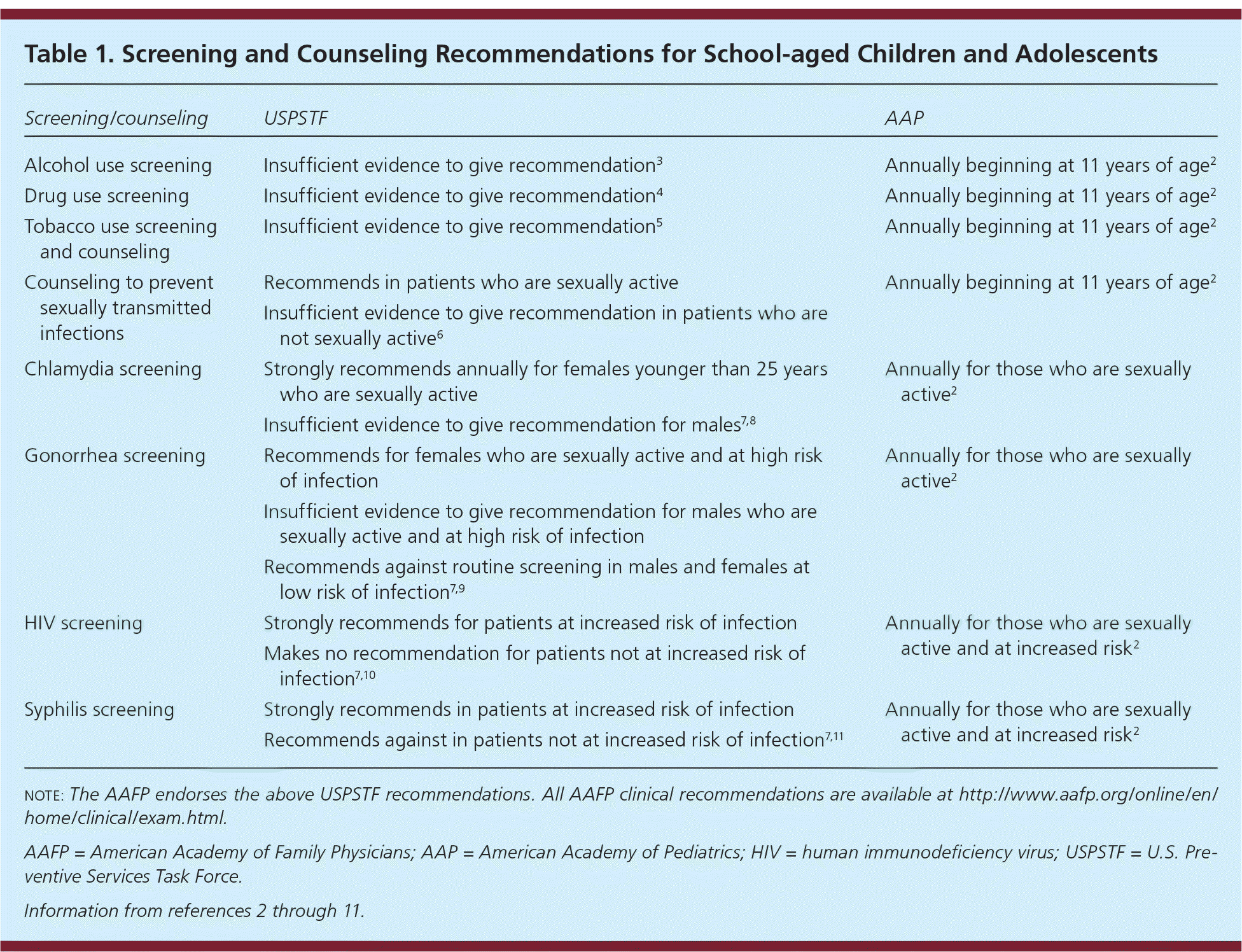
| Screening/counseling | USPSTF | AAP |
|---|---|---|
| Alcohol use screening | Insufficient evidence to give recommendation3 | Annually beginning at 11 years of age2 |
| Drug use screening | Insufficient evidence to give recommendation4 | Annually beginning at 11 years of age2 |
| Tobacco use screening and counseling | Insufficient evidence to give recommendation5 | Annually beginning at 11 years of age2 |
| Counseling to prevent sexually transmitted infections | Recommends in patients who are sexually active | Annually beginning at 11 years of age2 |
| Insufficient evidence to give recommendation in patients who are not sexually active6 | ||
| Chlamydia screening | Strongly recommends annually for females younger than 25 years who are sexually active | Annually for those who are sexually active2 |
| Insufficient evidence to give recommendation for males7,8 | ||
| Gonorrhea screening | Recommends for females who are sexually active and at high risk of infection | Annually for those who are sexually active2 |
| Insufficient evidence to give recommendation for males who are sexually active and at high risk of infection | ||
| Recommends against routine screening in males and females at low risk of infection7,9 | ||
| HIV screening | Strongly recommends for patients at increased risk of infection | Annually for those who are sexually active and at increased risk2 |
| Makes no recommendation for patients not at increased risk of infection7,10 | ||
| Syphilis screening | Strongly recommends in patients at increased risk of infection | Annually for those who are sexually active and at increased risk2 |
| Recommends against in patients not at increased risk of infection7,11 |
Well-child visits for school-aged children are typically conducted with a parent present. However, discussions about sensitive issues, such as substance use and sexual activity, should occur without the parent in the room to allow for a sense of privacy. Confidentiality laws should be addressed with the patient and the parent before initiating these discussions to promote open communication.
Healthy Lifestyle
DIETARY COUNSELING
Although many studies have addressed diet and weight control, few give definitive evidence on how to best advise patients and families. The most effective methods for weight loss in children who are overweight or obese are comprehensive behavioral interventions composed of more than 25 hours of counseling over six months, typically at a specialty center. Less intensive interventions have not been shown to significantly affect weight loss.12
Most experts recommend providing some dietary counseling to children and their families at the well-child examination, focusing on increased intake of fruits and vegetables, whole grains, low-fat and nonfat dairy products, beans, fish, and lean meats. Families should also be advised to limit sugary beverages, fast food, and highly processed foods, and be educated on appropriate portion sizes.
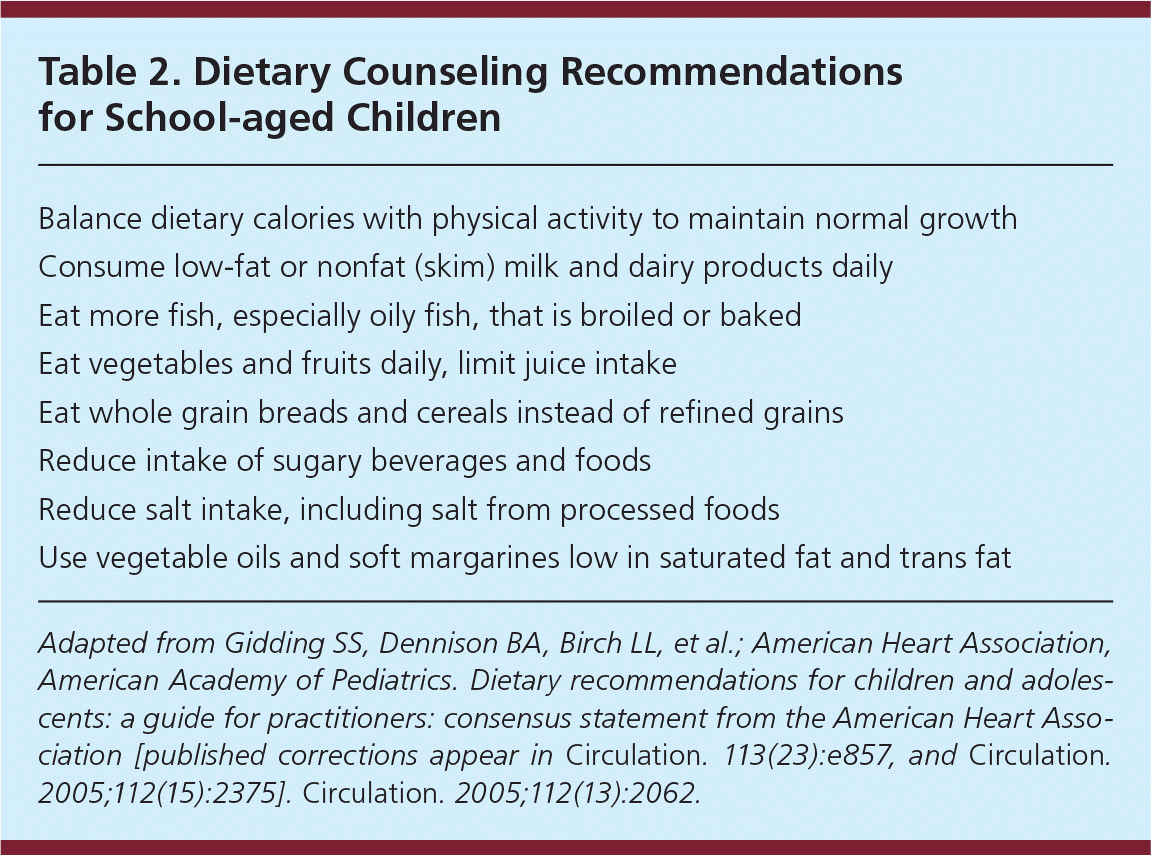
| Balance dietary calories with physical activity to maintain normal growth |
| Consume low-fat or nonfat (skim) milk and dairy products daily |
| Eat more fish, especially oily fish, that is broiled or baked |
| Eat vegetables and fruits daily, limit juice intake |
| Eat whole grain breads and cereals instead of refined grains |
| Reduce intake of sugary beverages and foods |
| Reduce salt intake, including salt from processed foods |
| Use vegetable oils and soft margarines low in saturated fat and trans fat |
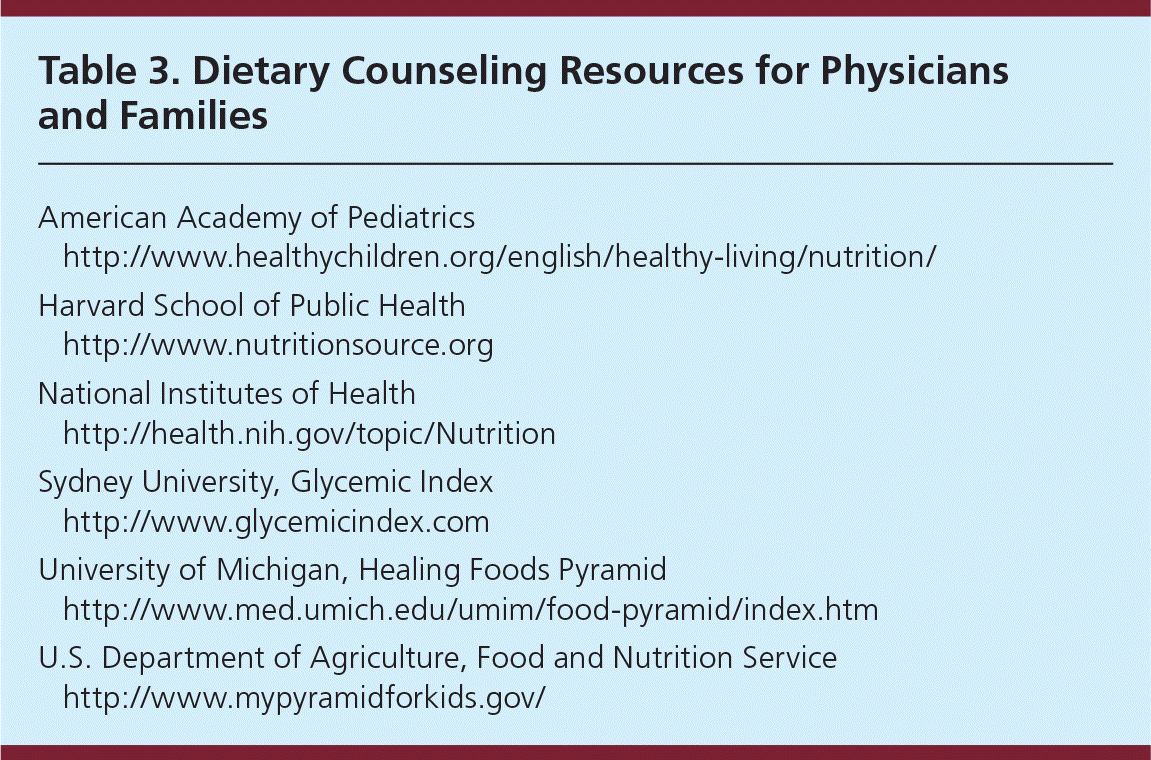
| American Academy of Pediatrics | |
| http://www.healthychildren.org/english/healthy-living/nutrition/ | |
| Harvard School of Public Health | |
| http://www.nutritionsource.org | |
| National Institutes of Health | |
| http://health.nih.gov/topic/Nutrition | |
| Sydney University, Glycemic Index | |
| http://www.glycemicindex.com | |
| University of Michigan, Healing Foods Pyramid | |
| http://www.med.umich.edu/umim/food-pyramid/index.htm | |
| U.S. Department of Agriculture, Food and Nutrition Service | |
| http://www.mypyramidforkids.gov/ | |
PHYSICAL ACTIVITY
Children should be active for at least 60 minutes each day, consisting of mostly moderate- or vigorous-intensity aerobic exercise.14,15 Table 4 lists physical activity recommendations from the National Institutes of Health.16 Play is encouraged for younger children over structured activities, and parents modeling an active lifestyle can be helpful. Community efforts, such as providing children with a safe place to play and an emphasis on physical activity at school, may also increase physical activity in children.17
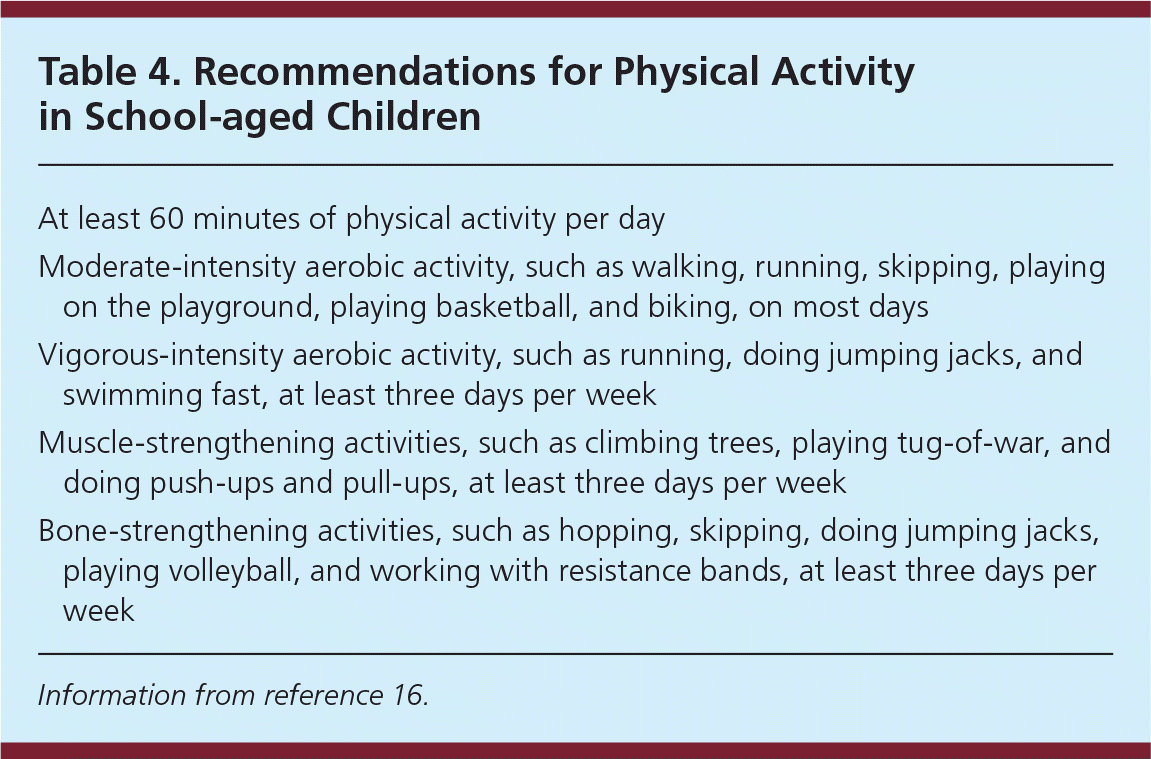
| At least 60 minutes of physical activity per day |
| Moderate-intensity aerobic activity, such as walking, running, skipping, playing on the playground, playing basketball, and biking, on most days |
| Vigorous-intensity aerobic activity, such as running, doing jumping jacks, and swimming fast, at least three days per week |
| Muscle-strengthening activities, such as climbing trees, playing tug-of-war, and doing push-ups and pull-ups, at least three days per week |
| Bone-strengthening activities, such as hopping, skipping, doing jumping jacks, playing volleyball, and working with resistance bands, at least three days per week |
SCREEN TIME
The average child spends 7.5 hours per day in front of a screen, including watching television, using the computer, or playing video games.18 The more time children spend in front of a screen, the higher their risk of obesity. Obesity rates are lowest in children who have less than one hour of screen time daily, and are highest in those who have greater than four hours of screen time daily.19,20 Screen time may also negatively affect body image and school performance, and promote violent behavior.21 Physicians should counsel families to limit screen time, and encourage children to replace screen time with physical activity. The AAP recommends limiting screen time to no more than one to two hours of quality programming daily.21
SLEEP
The average school-aged child sleeps 9.4 hours per night,22 although 11 hours per night is ideal in this age group.23 Physicians should counsel families on sleep requirements, because inadequate sleep can lead to negative effects, such as behavioral issues, difficulty concentrating at school, and obesity.24,25 Snoring or excessive daytime sleepiness may be a sign of sleep apnea and should prompt further questioning.
DENTAL CARE
School-aged children should have a dental home in addition to a medical home, and should see a dentist twice per year for a checkup and cleaning. Sugary foods and beverages should be limited, particularly between meals, and children should brush their teeth twice per day with a pea-sized amount of toothpaste containing fluoride.26 The AAP also recommends flossing daily as soon as two teeth touch each other.27
Safety
Unintentional injuries are the leading cause of death for school-aged children in the United States, with most of these injuries caused by motor vehicle crashes or drownings. 28 Falls are the leading cause of nonfatal injury in this age group.28 Ninety percent of injuries are thought to be preventable and predictable, and outpatient counseling on injury prevention has been shown to decrease injury rates in children.29,30 School-aged children should be taught safety precautions, and parents should be encouraged to model safe behaviors.31 The AAP recommends counseling families about traffic, water, sports, and firearm safety 31 (Table 532–42 ).
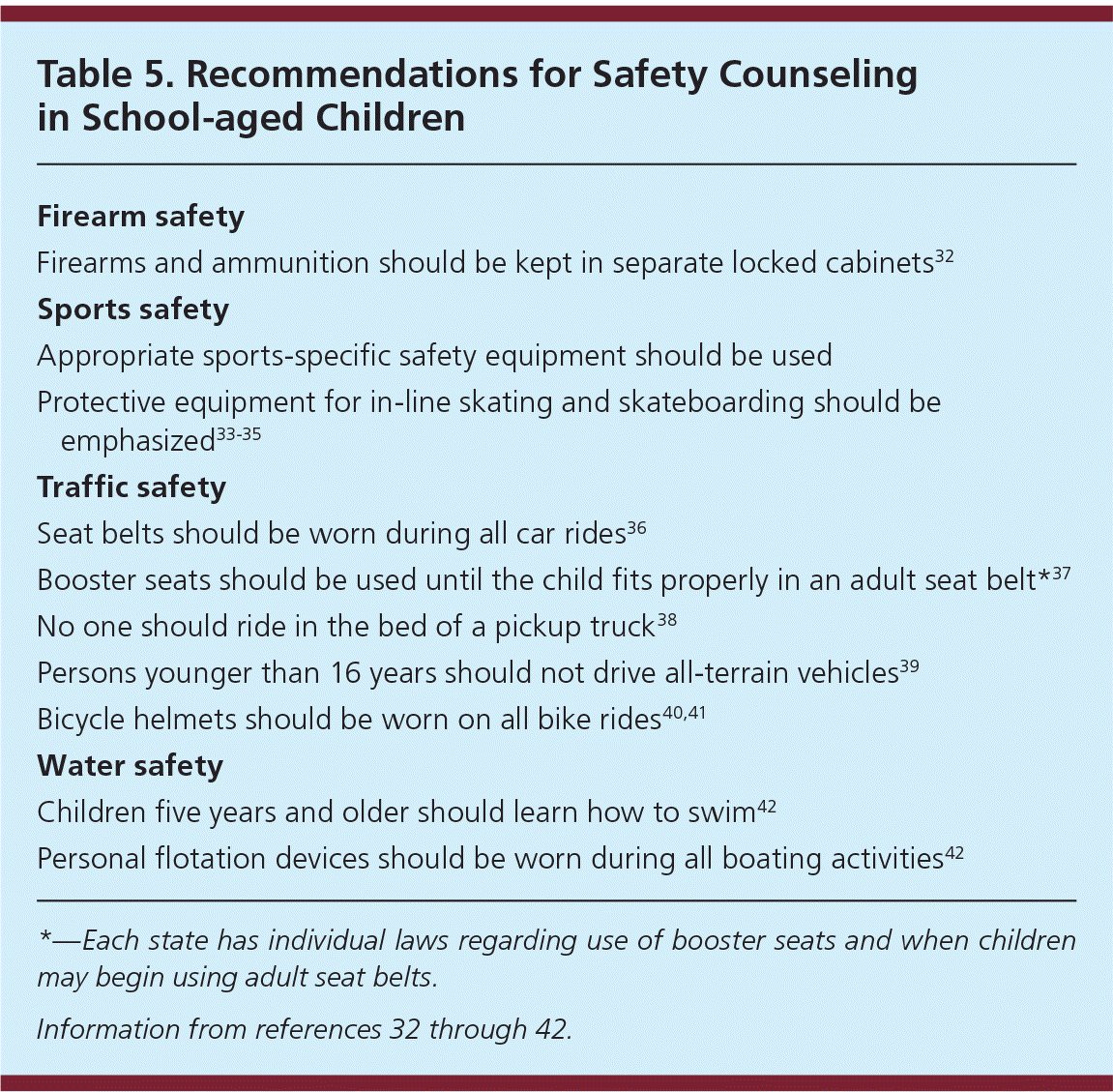
| Firearm safety |
| Firearms and ammunition should be kept in separate locked cabinets32 |
| Sports safety |
| Appropriate sports-specific safety equipment should be used |
| Protective equipment for in-line skating and skateboarding should be emphasized33–35 |
| Traffic safety |
| Seat belts should be worn during all car rides36 |
| Booster seats should be used until the child fits properly in an adult seat belt*37 |
| No one should ride in the bed of a pickup truck38 |
| Persons younger than 16 years should not drive all-terrain vehicles39 |
| Bicycle helmets should be worn on all bike rides40,41 |
| Water safety |
| Children five years and older should learn how to swim42 |
| Personal flotation devices should be worn during all boating activities42 |
High-Risk Behaviors
TOBACCO, ALCOHOL, AND DRUG USE
Tobacco, alcohol, and illicit drug use may begin in early adolescence. According to a 2007 survey of youth in the United States, 24 percent of those younger than 13 years had had their first drink of alcohol, 15 percent had smoked an entire cigarette, and 8 percent had tried marijuana.43 Early alcohol and substance abuse increases the risk of unintentional injuries, motor vehicle crashes, and substance abuse and dependence in adulthood.44
Although the American Academy of Family Physicians recognizes that the avoidance of tobacco, alcohol, and illicit drugs in adolescents is desirable,45 the effectiveness of physician counseling in this area is unknown.4,5 The AAP recommends asking adolescents directly about tobacco (including smokeless tobacco), alcohol, and drug use annually beginning at 11 years of age.2 If the patient reports substance use, additional questioning on duration, amount, and frequency is appropriate.
The CRAFFT (car, relax, alone, forget, friends, trouble) questionnaire is one brief screening tool that has been validated in the primary care setting to identify substance abuse in adolescents46:
Have you ever ridden in a car driven by someone who was “high” or had been using alcohol or drugs?
Do you ever use alcohol or drugs to relax, feel better about yourself, or fit in?
Do you ever use alcohol or drugs when you are by yourself?
Do you ever forget things you did while you were using alcohol or drugs?
Do your family or friends ever tell you that you should cut down on your drinking or drug use?
Have you ever gotten into trouble while you were using alcohol or drugs?
Physicians would give one point for each “yes” answer to the previous questions. A score of 2 or more should prompt concern for substance abuse or dependence.
SEXUAL ACTIVITY
Family physicians should consider screening early adolescents for sexual activity. More than 7 percent of American youths are sexually active before 13 years of age, and even earlier sexual activity is seen in inner city youth.43 Approximately one-third of sexually active adolescents 11 or 12 years of age have sexual partners who are more than five years older.47 Many states consider sexual activity of an adolescent with a partner who is at least three years older statutory rape, and a reportable offense even if it is consensual.48 In most states, discussions of contraception and sexually transmitted infection diagnosis and treatment between physicians and patients 12 years and older are protected under confidentiality laws.49 Physicians need to be aware of their own state's laws governing sexual activity in adolescents.
All sexually active adolescents are at risk of sexually transmitted infections; therefore, the U.S. Preventive Services Task Force recommends that these patients receive counseling on prevention.6 Sexually active females younger than 25 years should receive annual screening for chlamydia, in addition to gonorrhea screening if they are at increased risk of infection due to sexual activity.7–9 Male and female patients with multiple partners or high-risk sexual behavior should also be screened for human immunodeficiency virus and syphilis.7,10,11 Because there is movement toward waiting to initiate cervical cancer screening until 21 years of age, sexually active females can be screened for chlamydia and gonorrhea through urine polymerase chain reaction testing, which does not require a pelvic examination.50 There is insufficient evidence to recommend for or against counseling non-sexually active adolescents on the prevention of sexually transmitted infections because it is unknown if physician counseling is effective in this group.6
